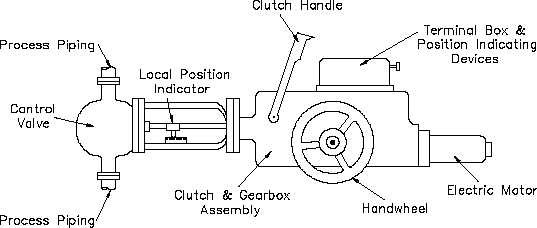Process Controls
VALVE ACTUATORS
A major advantage of solenoid actuators is their quick operation. Also, they are much easier to
install than pneumatic or hydraulic actuators.
However, solenoid actuators have two
disadvantages. First, they have only two positions: fully open and fully closed. Second, they
don’t produce much force, so they usually only operate relatively small valves.
Electric Motor Actuators
Electric motor actuators vary widely in their design and applications. Some electric motor
actuators are designed to operate in only two positions (fully open or fully closed). Other electric
motors can be positioned between the two positions. A typical electric motor actuator is shown
in Figure 39. Its major parts include an electric motor, clutch and gear box assembly, manual
handwheel, and stem connected to a valve.
Figure 39 Electric Motor Actuator
The motor moves the stem through the gear assembly. The motor reverses its rotation to either
open or close the valve. The clutch and clutch lever disconnects the electric motor from the gear
assembly and allows the valve to be operated manually with the handwheel.
Most electric motor actuators are equipped with limit switches, torque limiters, or both. Limit
switches de-energize the electric motor when the valve has reached a specific position. Torque
Rev. 0
Page 59
IC-07


